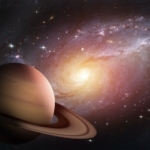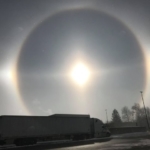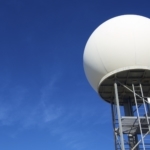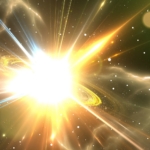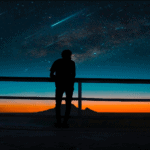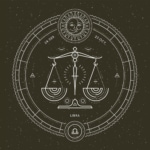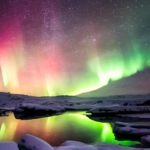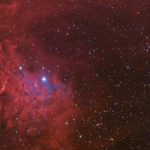July’s night sky highlights include the full Buck Moon, your last chance to see Mars for quite some time, and an opportunity to catch a shooting star or three! Learn everything you need to know about the night sky in our calendar of sky events here.
By the way, do you have your “star binoculars” yet? How about a telescope? Did you know that many local libraries allow you to borrow these items? They are not required for stargazing, but many sights are best seen with optical enhancement!
Look for the telescope emoji – 🔭 – as a quick reference for sky events where we particularly recommend them.
Bookmark this page now (Press command+D on your keyboard) so you can easily refer to it over the next few weeks. If you’re interested in locating particular planets in the sky throughout the year, take a look at our visible planets guide.
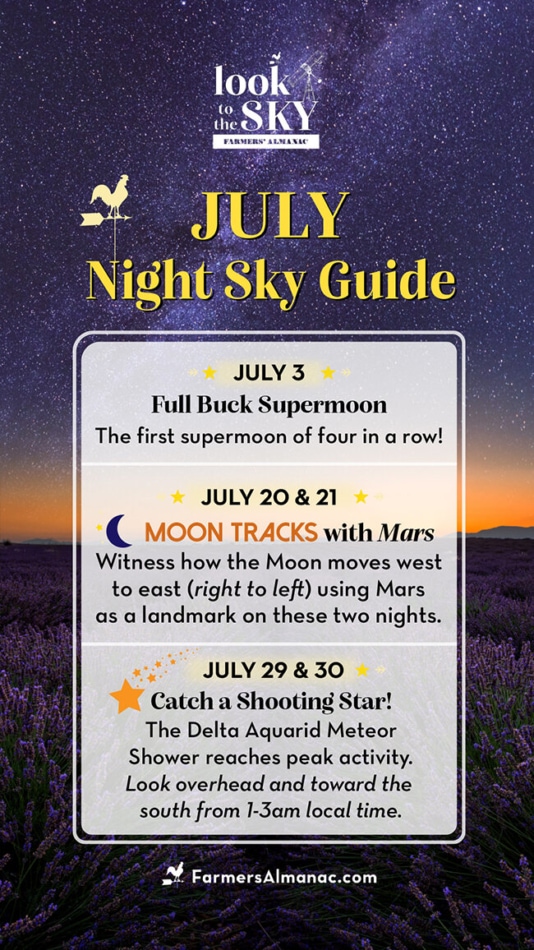
July Night Sky Guide
July 1 – Mercury Superior Conjunction
Mercury is at superior conjunction today. That means it is passing behind the Sun and will be invisible from Earth. During this time, the planet transitions from “morning star” (visible in the early dawn hours) to “evening star” (visible after sunset). In a couple of weeks it will re-emerge from the Sun’s fiery glow as a “star” visible in early twilight hours. (See July 19 below.)
⭐ July 3 – Full Buck Moon
The full Buck Moon reaches peak illumination at 7:39 a.m. EDT. (This means that it may appear to be brighter the night before.)
Free Buck Moon astrology report – tap here!
Learn more about the Buck Moon in the following video:
July 6 – Earth At Aphelion
Earth reaches its farthest distance from the Sun at 4:06 p.m. EDT on this day. At that time our planet will be 94,506,364 miles from the Sun (measured center to center).
🔭 July 7 – Saturn And The Moon, Venus
Early morning: Look southeast at 2 a.m. local time to see the waning gibbous Moon. The bright yellow-white “star” shining about three degrees above it is the planet Saturn. Currently in eastern Aquarius, Saturn rises in the east-southeast around 11:30 p.m. (local time) in early July, but by the end of the month it rises in late twilight.
Early evening: This evening, dazzling Venus shines at magnitude -4.7, the planet’s maximum brightness for the year. Even in a small telescope, you will be able to see the bright planet. It will look like a crescent shape (similar to a waxing crescent Moon, illuminated by the Sun on its right side). In the next few weeks, Venus will sink lower in the twilight sky and disappear over the western horizon earlier and earlier. (In August it will appear again—this time in the early morning sky as a “morning star.”)
July 9 – Last Quarter Moon
The last quarter Moon occurs at 9:48 p.m. EDT.
🔭 July 10 – Mars And Regulus (Leo)
Look west just after sunset for a glimpse of Mars and Regulus (the star that symbolizes the heart of Leo, the Lion). We recommend using binoculars. This evening Mars will pass less than three-quarters of a degree above Regulus.
]If you live in an area that doesn’t have any tall buildings or trees, locate Venus near the western horizon first. Then scan the sky several degrees to its upper left to find Mars and Regulus. They are all getting very low in the sky.
Mars is faint and is so far away on the opposite side of the Sun that, in a telescope, its disk appears like a tiny dot. It’s about as far from Earth as it can get—211 million miles away.
July 11 – Jupiter And Crescent Moon
A couple of hours before the break of dawn, look a quarter of the way up from the eastern horizon to see a fat waning crescent Moon, and about a half dozen degrees to its lower left, shining brilliantly will be Jupiter.
July 13-14 — The Northern Lights
If you live in Maine, Michigan, Wisconsin, or Montana (or happen to be visiting) look to the sky between the hours of 10pm-2am (Thursday night into Friday morning). You may be able to catch the elusive and beautiful rainbow colored skies of the Aurora Borealis also known as The Northern Lights. Learn more about this magical phenomenon.
July 17 – New Moon “Star View”
The new Moon occurs at 2:32 p.m. EDT.
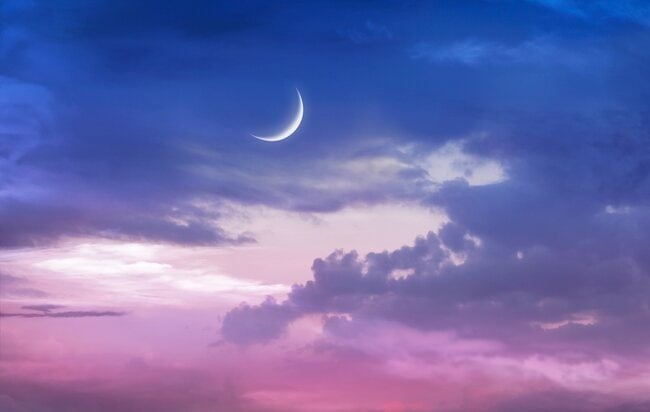
July 18 – The “Coat Hanger” Asterism
Up for a challenge? Most stargazers have heard of the Pleiades, Hyades, and the Beehive (mentioned in the June Night Sky Guide), but what about the “Coat Hanger?” Some evening this week at around 10:30 p.m. local time, turn your binoculars southeast to the region of the sky roughly halfway between the bright stars Altair and Vega and you will discover Brocchi’s Cluster in the constellation of Vulpecula (pronounced Vul-peck-kula) the Fox.
During the 1920s Dalmiro Francis Brocchi, chart maker for the American Association of Variable Star Observers (AAVSO) designed a map depicting the region of the sky around Vulpecula, revealing this cluster. For some reason though, Brocchi’s Cluster is hardly ever mentioned in most astronomy books. Yet, it is the brightest of all the star clusters in that part of the sky.
In a clear, dark sky you might perceive it with the naked eye as a fuzzy patch of light, but in binoculars you’ll see it as a curious grouping of stars. An east-west line of six stars forms a crossbar and four more form a hook attached to its middle, which looks like an inverted coat hanger. These 10 stars are all 5th to 7th magnitude. In the Swedish astronomer’s Per Collinder’s star catalogue, drawn-up in 1931, it is cluster No. 399, hence its “official” designation, Collinder 399.
Learn the difference between constellations and asterisms – Tap here!
🔭 July 19 – Venus, Mercury, And The Crescent Moon
About one half hour after sunset, look low on the western horizon for Venus, which serves as a landmark for locating a very thin waxing crescent Moon about a fist-widths at arm’s length to its right.
About half a fist-width to the lower right of the Moon will be Mercury (reappearing as an “evening star” in the twilight sky).
Scanning this region of the sky with binoculars will improve your chances of sighting all three. Note: Find a clear view of the horizon without trees or tall buildings.
⭐ July 20+21 – Moon Tracks with Mars
Did you know that the Moon moves right to left (west to east) over the course of the month? (This is the opposite direction that it appears to move on any given night.) Get a glimpse of its true motion as it orbits the Earth by using Mars as a landmark on these two nights! (Mars is much slower moving than the Moon, so it makes a great reference point.)
On the first night, July 20, the waxing crescent Moon will be positioned to the upper right of Mars. The following night, July 21, the Moon will be positioned well to the upper left of the tiny planet. Bear in mind that Mars will be very faint in the sky!
If either of these two nights happens to be cloudy or foggy, rest assured there will be many other chances to track the Moon in the future. Stick with us!
🔭 July 21 – Venus, Mars, And The Crescent Moon
This evening, a slightly wider crescent Moon stands eight degrees above Venus. Regulus lies almost directly between them. And sitting about 4 degrees to the left of the Moon will be Mars. Again, binoculars will be beneficial in sighting all of them.
July 25 – First Quarter Moon
The first quarter Moon occurs at 6:07 p.m. EDT.
🔭 July 28 – Mercury And Regulus Conjunction
Look west approximately 30 minutes after sunset to spot Mercury and Regulus (mentioned above on July 12). On this day at 8 p.m. EDT, Mercury passes 0.1 degrees west-southwest of Regulus. In other words they will be extremely close together!
Mercury is fading but still outshines Regulus by far. Observers in lower latitudes will have a better view of this very tight conjunction.
If you happen to be in an area where there are no tall buildings or trees, you could possibly still be able to see Venus as well. Mercury and Regulus will be hanging above Venus—about half of the width of your fist.
⭐ July 29+30 – Catch A Shooting Star!
The southern Delta Aquarid Meteor Shower Peaks on these early mornings. Look overhead and toward the south between the hours of 1-3am local time.
Several weak, long-lasting meteor showers that emanate from out of the southern sky are active from mid-July through August. The most pronounced is the Delta Aquarid shower, which has two broad peaks.
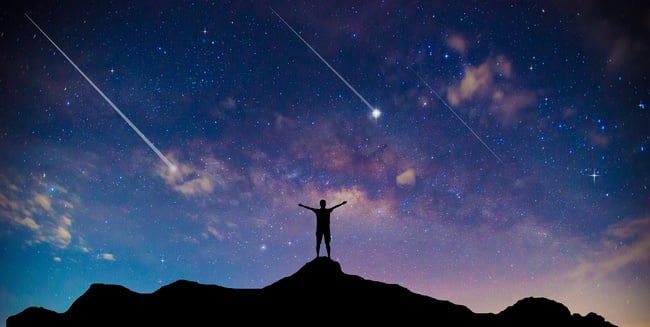
The southern Delta Aquarids last for roughly a week centered on these mornings, when the Moon is a waxing gibbous and sets around 2 a.m. local time, leaving the rest of the night dark and without any interference from bright moonlight.
The northern Delta Aquarids last for a week around August 12th, right when many skywatchers will be watching for the Perseid shower. Each branch of the Delta Aquarids produces 10 to 20 meteors per hour under dark sky conditions.
Degrees Explained
Did you know that you can use the size of your hand to judge distances between objects in space? See our illustration below:
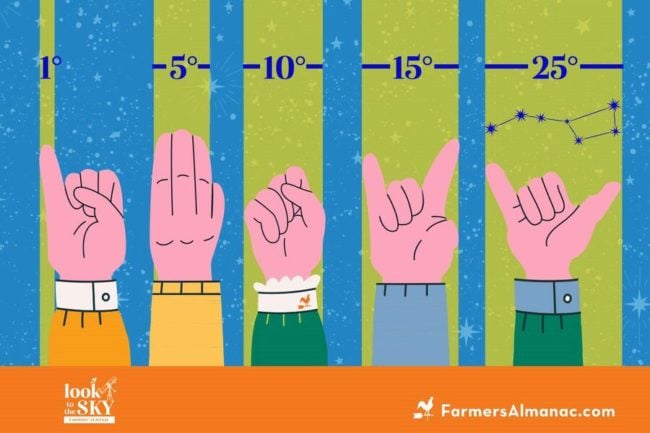
Magnitudes Explained
Magnitudes refer to the brightness of an object in space. The lower the number, the more dazzling it is. Bright stars are 1 or 0 magnitude. Fainter ones are 5 or 6. Super bright stars are in negative numbers. For instance, Sirius is magnitude -1.4. (For reference, the full Moon is -12.7 and the Sun is -26.7.)
Footnote
All times and positions are listed in Eastern Standard Time, 40 degrees north of the equator—unless listed otherwise.
If the term “local time” is used, that means the time is true for every time zone (no adding or subtracting hours is necessary). Any mentions of sunset, midnight, and sunrise are also true according to your location.
Get your local sunrise, sunset, moonrise, and moonset times at The Farmhouse – Come on in!
Join The Discussion
What sky event are you looking forward to in July’s night sky?
Share your excitement with your community here in the comments below!
Related Articles
Full Moon July 2023 – Buck Moon And Alternative Names

Joe Rao
Joe Rao is an esteemed astronomer who writes for Space.com, Sky & Telescope, and Natural History Magazine. Mr. Rao is a regular contributor to the Farmers' Almanacand serves as an associate lecturer for the Hayden Planetarium in New York City.


